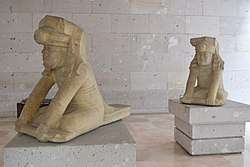El Azuzul
El Azuzul is an Olmec archaeological site in Veracruz, Mexico, a few kilometers south of the San Lorenzo Tenochtitlán complex and generally considered contemporary with it (perhaps 1100 to 800 BCE). Named for the ranch on which it is located, El Azuzul is part of the Loma del Zapote complex. The site occupies the higher elevations north of the confluence of two ancient river courses, a part of the Coatzacoalcos River system. It is upstream of the monumental earthworks at Potrero Nuevo, which is part of the San Lorenzo complex.


.jpg)
Monumental art
El Azuzul is best known for two pairs of monumental sculptures, now on exhibit at the Museo de Antropologia, Xalapa, Mexico. These statues were found on the south side of the large pyramid/hill on the site, intact and apparently undisturbed since they were placed there in Pre-Classic times.
The first pair of statues, described as "some of the greatest masterpieces of Olmec art",[1] are nearly identical seated human figures. When discovered the two statues were facing east, one behind the other (see bottom photo). Some researchers have suggested that these "twins" are forerunners of the Maya Hero Twins from the Popul Vuh,[2] although their headdresses have led others to describe them as priests.[3] The twin's headdresses have been mutilated, probably to erase identifying insignia.[4]
Each twin, like the figure in San Martín Pajapan Monument 1, is grasping a ceremonial bar with his right hand under the bar and his left over, caught in the act of raising what has been described as an axis mundi or Mesoamerican world tree.[5]
Facing these two humans was a feline-like statue, generally identified as a jaguar. Slightly larger than the humans it faced, the feline is roughly 1.2 meters high. A 1.6 meter version of this feline was found a few meters away, to the northeast. The jaguars show evidence of having been recarved from earlier monuments.[6]
The humans are similar to other Olmec sculpture, in particular San Martin Pajapan Monument 1, where a young lord also attempts to lift a ceremonial bar. Despite its "tantalizing hints of [a] lost mythic cycle",[7] it is not known with any clarity what this four statue tableau illustrates.
Structures
In addition to the large pyramid/hill, a long causeway or dike was constructed along the waterway, possibly functioning as a levee and/or wharf.[8] El Azuzul also contains other possible structures, now completely overgrown.
Notes
- Pool, p. 118.
- "The physical arrangement and characteristics of human figures and felines bear uncanny symbolic resemblances to later period myths from the Maya and Central Mexican cultures about twins and jaguars." Cyphers (1999), p. 174
- For example, in a caption describing a jaguar figurine that was found together with these two statues, Southampton and UCL archaeology professor Nicholas Saunders describes the statues as "...dos piezas que representan a gobernantes o sacerdotes olmecas" ["two pieces that represent Olmec governors or priests"]; quote from Saunders 2005, p.22.
- Cyphers (1999), p. 19.
- Pool, p. 143. Cyphers refers to a sense of "imminent movement", p. 19.
- Pool, p. 121; Cyphers (1999).
- Joralemon (1996), p. 59.
- Pool, p. 102
References
- Cyphers, Ann (1999). "From Stone to Symbols: Olmec Art in Social Context at San Lorenzo Tenochtitlán" (PDF). In David C. Grove; Rosemary A. Joyce (eds.). Social patterns in pre-classic Mesoamerica: a symposium at Dumbarton Oaks, 9 and 10 October 1993. Washington D.C.: Dumbarton Oaks Research Library and Collection and Trustees for Harvard University. pp. 155–181. ISBN 0-88402-252-8. OCLC 39229716. Retrieved 8 September 2019.
- Cyphers, Ann; Fernando Botas (1994). "An Olmec Feline Sculpture from El Azuzul, Southern Veracruz". Proceedings of the American Philosophical Society. Philadelphia, PA: APS. 138 (2): 273–283. ISSN 0003-049X. OCLC 55941028.
- Joralemon, Peter David (1996). "In Search of the Olmec Cosmos: Reconstructing the World View of Mexico's First Civilization". In Elizabeth P. Benson; Beatriz de la Fuente (eds.). Olmec Art of Ancient Mexico: Catalogue to accompany an exhibition at the National Gallery of Art, Washington, June 30 to Oct. 20, 1996. Washington D.C.: National Gallery of Art. pp. 51–60. ISBN 0-89468-250-4. OCLC 34357584.
- Pool, Christopher A. (2007). Olmec Archaeology and Early Mesoamerica. Cambridge World Archaeology. Cambridge and New York: Cambridge University Press. ISBN 978-0-521-78882-3. OCLC 68965709.
- Saunders, Nicholas J. (March–April 2005). "El icono felino en México: fauces, garras y uñas" (PDF). Arqueología Mexicana (in Spanish). México, D.F.: Instituto Nacional de Antropología e Historia, Editorial Raíces. 12 (72): 20–27. ISSN 0188-8218. OCLC 29789840. Archived from the original (PDF online facsimile) on 2009-10-07.